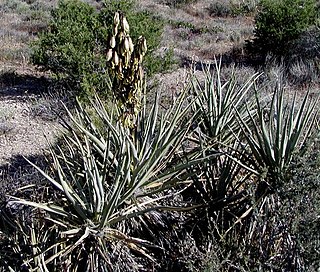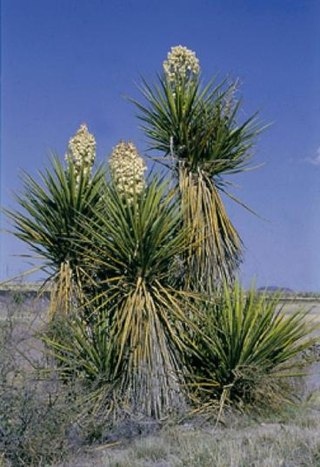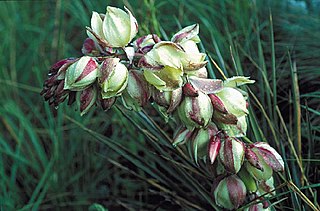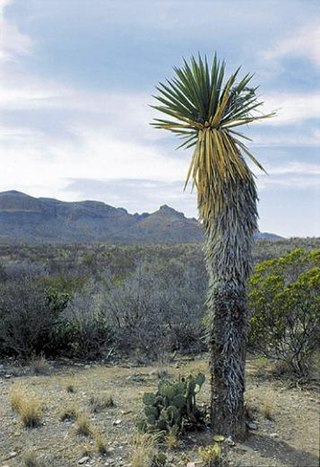
Yucca brevifolia is a plant species belonging to the genus Yucca. It is tree-like in habit, which is reflected in its common names.

The Chihuahuan Desert is a desert ecoregion designation covering parts of northern Mexico and the southwestern United States. It occupies much of far West Texas, the middle to lower Rio Grande Valley and the lower Pecos Valley in New Mexico, and a portion of southeastern Arizona, as well as the central and northern portions of the Mexican Plateau. It is bordered on the west by the Sonoran Desert, the Colorado Plateau, and the extensive Sierra Madre Occidental range, along with northwestern lowlands of the Sierra Madre Oriental range. Its largest, continual expanse is located in Mexico, covering a large portion of the state of Chihuahua, along with portions of Coahuila, north-eastern Durango, the extreme northern part of Zacatecas, and small western portions of Nuevo León. With an area of about 501,896 km2 (193,783 sq mi), it is the largest desert in North America. The desert is fairly young, existing for only 8000 years.

Yucca baccata is a common species of yucca native to the deserts of the southwestern United States and northwestern Mexico, from southeastern California north to Utah, east to western Texas and south to Sonora and Chihuahua. It is also reported in the wild in Colombia.

Yucca schidigera, also known as the Mojave yucca or Spanish dagger, is a flowering plant native to the southwest deserts of North America.

Yucca elata is a perennial plant, with common names that include soaptree, soaptree yucca, soapweed, and palmella. It is native to southwestern North America, in the Sonoran Desert and Chihuahuan Desert in the United States, southern Nevada, southwestern Utah, and northern Mexico. Yucca elata is widely distributed, although its population appears to be decreasing.
Juniperus coahuilensis, commonly known as redberry juniper, is a species of conifer in the family Cupressaceae.

Yucca rostrata also called beaked yucca, is a tree-like plant belonging to the genus Yucca. The species is native to Texas, and the Chihuahua and Coahuila regions of Mexico. This species of Yucca occurs in areas that are arid with little annual rainfall.

Yucca faxoniana is a bladed evergreen shrub of the genus Yucca. It is known by the common names Faxon yucca,Spanish dagger, and giant dagger.

Yucca × schottii is a plant species in the genus Yucca, native to southern Arizona, southwestern New Mexico, and the northern parts of Sonora and Chihuahua. The common names are Schott's yucca, hoary yucca, and mountain yucca. The "×" in the name indicates that this is a nothospecies, regarded as being a natural hybrid between two other species. In this case, Yucca × schottii is believed to have originated as a hybrid between Y. baccata and Y. madrensis. Yucca × schottii is firmly established and does reproduce freely in the wild.

Yucca jaliscensis is a Yucca species native to the highlands of southwestern Mexico. Common names for this species include Jalisco Yucca, Jalisco Soapwort, Izote Yucca. It is native to mountainous areas at about 5000 feet in the States of Jalisco, Colima and Guanajuato.

Yucca madrensisH. S. Gentry is a plant in the genus Yucca in the family Asparagaceae. It is native to a mountainous region in the Sierra Madre Occidental in the Mexican states of Sonora and Chihuahua. It has also been reported from Arizona It grows on steep, rocky slopes in pine-oak forests.

Yucca neomexicanaWooton & Standl. is a plant in the family Asparagaceae, native to New Mexico, Colorado and Oklahoma. Common name is "New Mexican Spanish bayonet." It is similar to Y. harrimaniaeTrel. but with a longer flowering stalk and white flowers.

Yucca potosina, English common name Potosí palm soapwort or Potosi palm, Rzed. is a plant species in the family Asparagaceae, native to the east central Mexico from Hidalgo to San Luís Potosí. It is sometimes cultivated as an ornamental, but not widely.

Yucca lacandonica is a plant species in the yucca genus with the common name "tropical yucca." It is native to Belize and to southern Mexico, the states of Chiapas, Veracruz, Tabasco, Quintana Roo, Campeche, and Yucatán. It is uniquely the only epiphytic species in the genus, although it has been reported to grow terrestrially as well.

Yucca carnerosana, commonly known as the giant Spanish dagger, is a species of North American plant in the asparagus family that grows in arid and desert climate areas. In the United States, it is confined to only a few counties in western Texas, where endemic populations are found in rocky outcrops. The species is, however, widely distributed in northern Mexico. It has a wide range and is abundant, and although it has local threats, its population appears to be stable overall.

Yucca thompsoniana, the Thompson's yucca, is a plant in the family Asparagaceae, native to Texas, Chihuahua and Coahuila. Other names for the plant include Beaked yucca, Soyate and Palmita.

Yucca intermediaMcKelvey is a species in the family Asparagaceae, with the common name intermediate Yucca. It is a relatively small plant forming clumps of rosettes. It is native to dry steppes, juniper-pinyon woodlands and savannahs, and desert grassland areas of the northwestern quarter of the US State of New Mexico, then into the Four Corners region, at an elevation of 1,400–2,300 m (4,600–7,500 ft).

Yucca treculianaCarrière is a species of flowering plant in the family Asparagaceae, native to Texas, New Mexico and Coahuila. Common names include Spanish dagger, Spanish bayonet and Don Quixote's lance.

Yucca aloifolia is the type species for the genus Yucca. Common names include aloe yucca, dagger plant, and Spanish bayonet. It grows in sandy soils, especially on sand dunes along the coast.

Hesperaloe funifera is a plant species native to Texas and northern Mexico, but sometimes cultivated as an ornamental elsewhere.




















